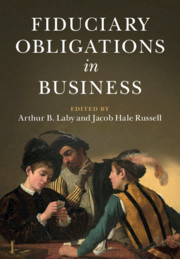Book contents
- Fiduciary Obligations in Business
- Fiduciary Obligations in Business
- Copyright page
- Dedication
- Contents
- Contributors
- Editors’ Acknowledgments
- Introduction The Decline and Rise of Fiduciary Obligations in Business
- Part I Identifying Fiduciaries and Their Duties
- Part II Gaps and Alternatives in Fiduciary Regimes
- 6 Conflicts of Interest in Investment Advice: An Expanded View
- 7 A System of Fiduciary Protections for Mutual Funds
- 8 Equitable Duty: Regulating Corporate Transactions in the Vicinity of Insolvency from a Comparative Perspective
- 9 Equity, Majoritarian Governance, and the Oppression Remedy
- 10 Fiduciary Relationships in Employee Benefit Plans
- Part III Historical and Comparative Perspectives
- Part IV Stakeholders and Society
- Index
7 - A System of Fiduciary Protections for Mutual Funds
from Part II - Gaps and Alternatives in Fiduciary Regimes
Published online by Cambridge University Press: 20 August 2021
- Fiduciary Obligations in Business
- Fiduciary Obligations in Business
- Copyright page
- Dedication
- Contents
- Contributors
- Editors’ Acknowledgments
- Introduction The Decline and Rise of Fiduciary Obligations in Business
- Part I Identifying Fiduciaries and Their Duties
- Part II Gaps and Alternatives in Fiduciary Regimes
- 6 Conflicts of Interest in Investment Advice: An Expanded View
- 7 A System of Fiduciary Protections for Mutual Funds
- 8 Equitable Duty: Regulating Corporate Transactions in the Vicinity of Insolvency from a Comparative Perspective
- 9 Equity, Majoritarian Governance, and the Oppression Remedy
- 10 Fiduciary Relationships in Employee Benefit Plans
- Part III Historical and Comparative Perspectives
- Part IV Stakeholders and Society
- Index
Summary
The regulation of mutual funds in the United States arguably contains the world’s most extensive system of fiduciary protection, buttressed by elaborate liability rules and a host of procedural protections and mandatory disclosure requirements designed to facilitate investor protection and choice. The intensity of this regulatory structure is a subject of perennial debate, as officials and analysts attempt to balance the cost of compliance and oversight against benefits to investors. Government officials have made numerous accommodations to ameliorate the system’s costs and facilitate industry innovations. But, the burdens of this enhanced system of fiduciary protections for mutual funds remain significant and have encouraged industry participants to evade these legal requirements in a number of ways, such as the creation of alternative vehicles for collective investments and the imbedding of regulated mutual funds into other legal structures that escape the full application of the enhanced system of fiduciary protections for mutual funds. This chapter suggests areas where aspects of mutual fund regulation might appropriately be extended to functionally similar investment vehicles.
Keywords
- Type
- Chapter
- Information
- Fiduciary Obligations in Business , pp. 132 - 151Publisher: Cambridge University PressPrint publication year: 2021
- 1
- Cited by

